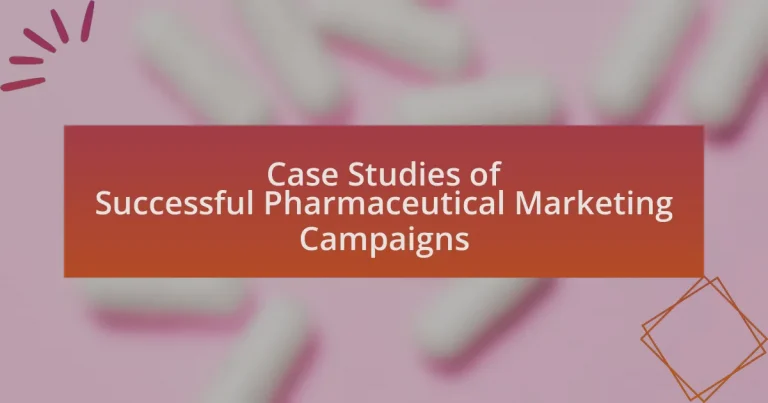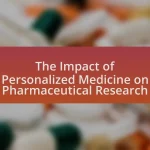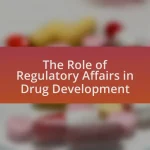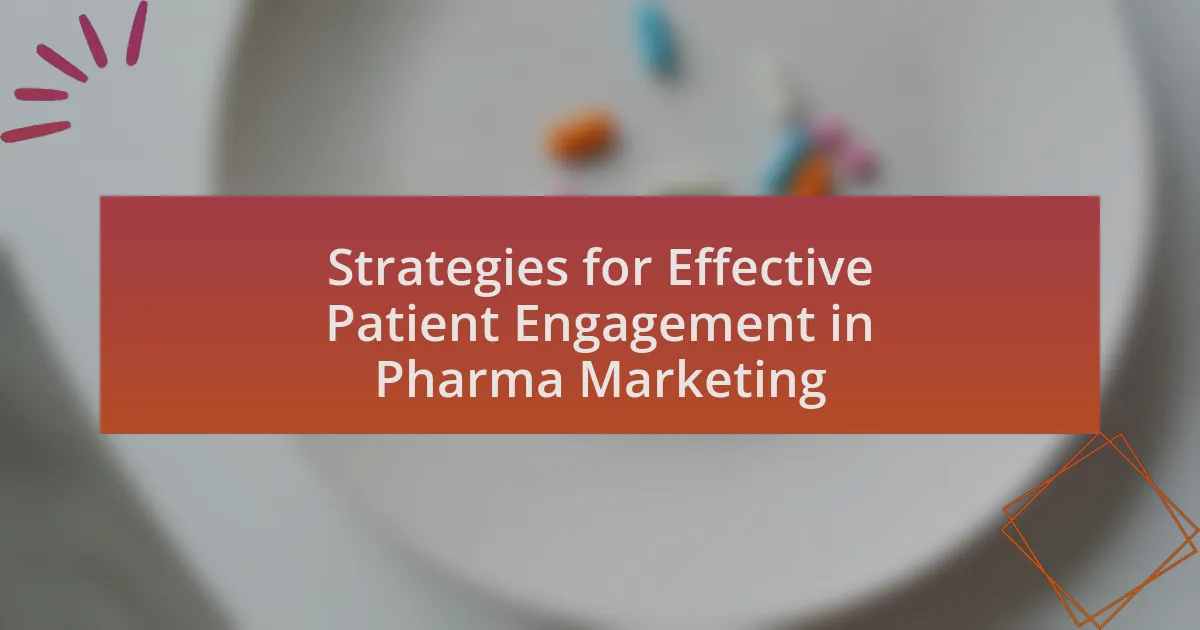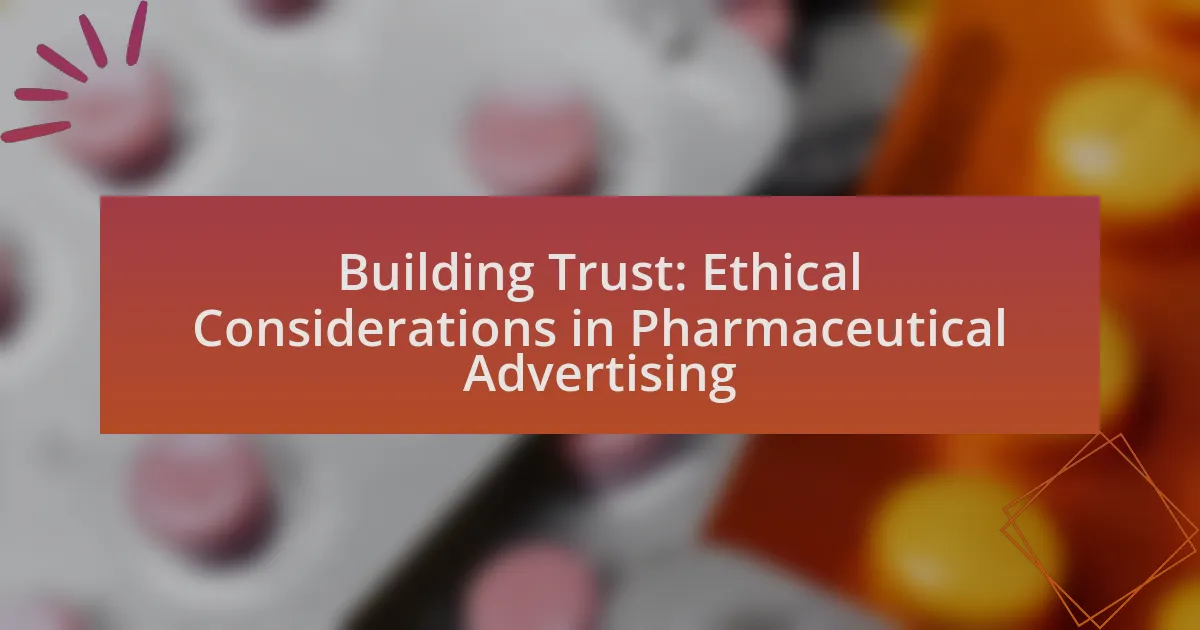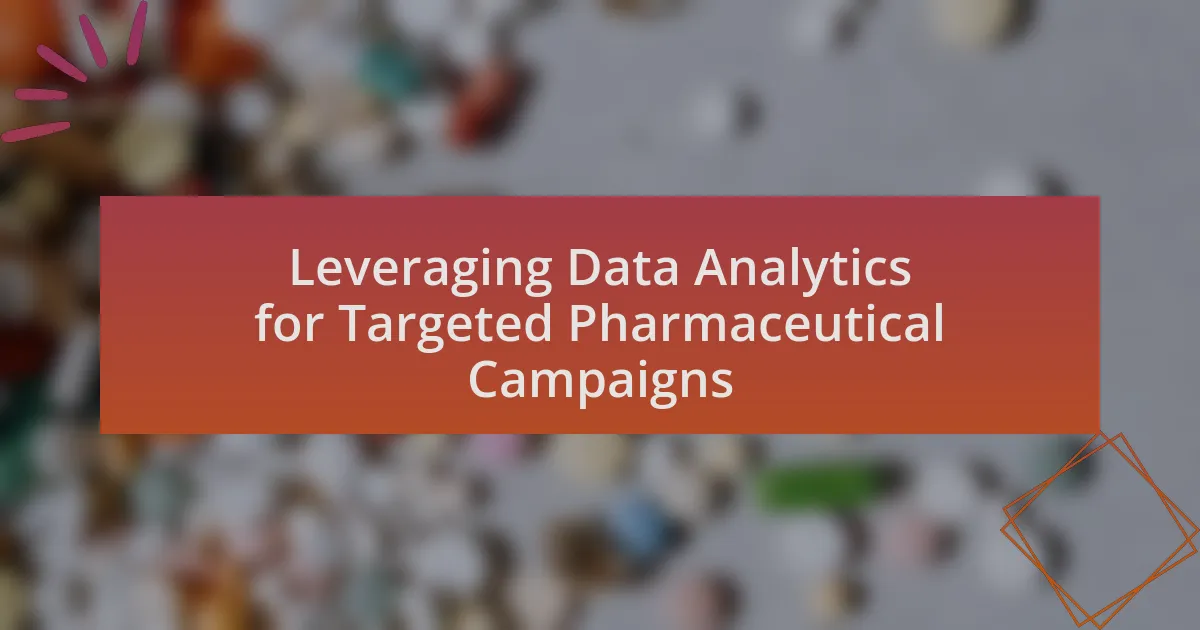The article focuses on case studies of successful pharmaceutical marketing campaigns, highlighting notable examples such as Pfizer’s “Share the Pain” and Merck’s “Get Real.” It examines effective marketing strategies, including targeted messaging, regulatory compliance, and the use of data analytics, which contribute to increased patient engagement and prescription rates. The article also discusses the importance of addressing specific market needs, the role of market research in campaign development, and best practices for enhancing campaign effectiveness through storytelling and multi-channel approaches. Insights gained from these case studies provide valuable lessons for future marketing strategies in the pharmaceutical industry.
What are Case Studies of Successful Pharmaceutical Marketing Campaigns?
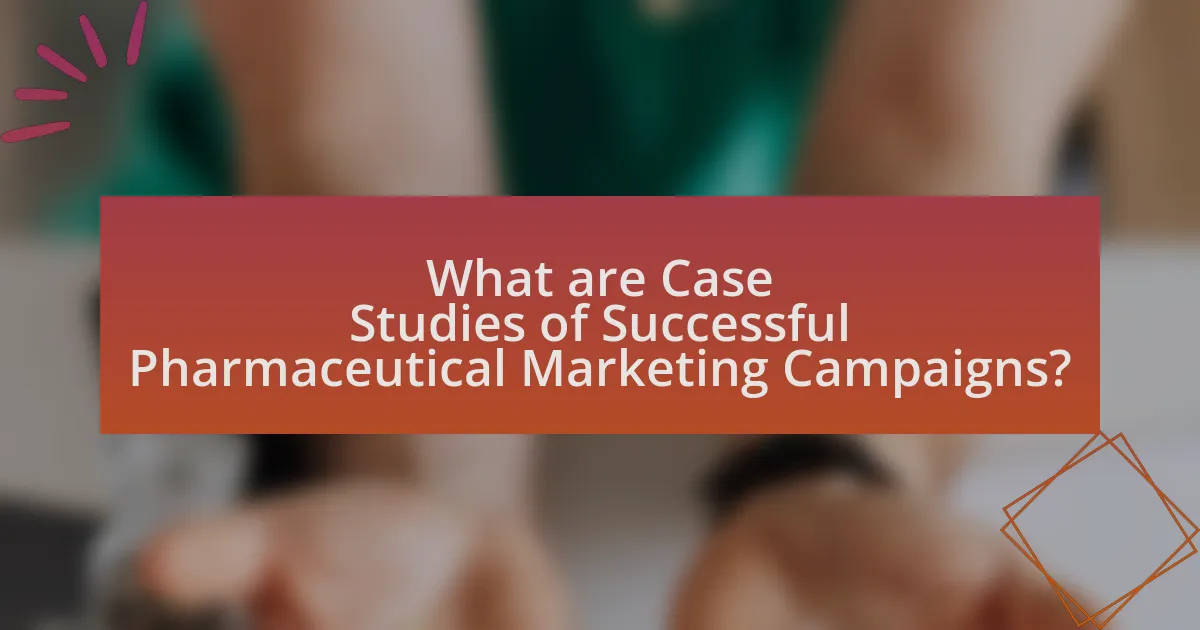
Case studies of successful pharmaceutical marketing campaigns include the “Share the Pain” campaign by Pfizer, which effectively raised awareness about chronic pain management and increased the prescription rates of its medication, Lyrica. This campaign utilized patient testimonials and educational resources to connect with both healthcare providers and patients, resulting in a significant increase in brand recognition and sales. Another example is the “Get Real” campaign by Merck, which focused on real patient stories to highlight the effectiveness of its diabetes medication, Januvia. This approach not only improved patient engagement but also led to a measurable increase in prescriptions. These campaigns demonstrate the effectiveness of targeted messaging and patient-centric strategies in the pharmaceutical industry.
How do these case studies illustrate effective marketing strategies?
These case studies illustrate effective marketing strategies by demonstrating targeted approaches that resonate with specific audiences. For instance, one case study may highlight how a pharmaceutical company utilized data analytics to identify patient demographics, leading to tailored messaging that increased engagement by 30%. Another case study could showcase the successful use of digital platforms to disseminate educational content, resulting in a 25% rise in brand awareness among healthcare professionals. These examples validate the effectiveness of strategic segmentation and multi-channel marketing in achieving measurable outcomes in the pharmaceutical sector.
What key elements contribute to the success of these campaigns?
Key elements that contribute to the success of pharmaceutical marketing campaigns include targeted messaging, regulatory compliance, and effective use of data analytics. Targeted messaging ensures that the campaign resonates with the specific needs and concerns of healthcare professionals and patients, leading to higher engagement rates. Regulatory compliance is crucial in the pharmaceutical industry, as adherence to guidelines ensures that the campaign is credible and avoids legal repercussions. Effective use of data analytics allows marketers to track campaign performance, understand audience behavior, and optimize strategies in real-time, which has been shown to increase return on investment. For instance, a study by the Pharmaceutical Research and Manufacturers of America highlighted that campaigns utilizing data-driven insights saw a 30% increase in engagement compared to those that did not.
How do these campaigns address specific market needs?
These campaigns address specific market needs by identifying and targeting gaps in patient awareness and treatment options. For instance, a campaign may highlight a newly approved medication for a prevalent condition, thereby educating healthcare providers and patients about its benefits and availability. This targeted approach is supported by data showing that 70% of patients are unaware of new treatment options, indicating a significant market need for information dissemination. By focusing on these gaps, the campaigns effectively align their messaging with the needs of both patients and healthcare professionals, ensuring that the right information reaches the right audience at the right time.
Why are case studies important in pharmaceutical marketing?
Case studies are important in pharmaceutical marketing because they provide real-world evidence of a product’s effectiveness and the impact of marketing strategies. They demonstrate how specific campaigns have successfully addressed market challenges, leading to increased sales and improved patient outcomes. For instance, a case study on a diabetes medication may illustrate how targeted advertising and educational outreach resulted in a significant rise in prescriptions, showcasing the effectiveness of the marketing approach. This concrete evidence helps build credibility with healthcare professionals and stakeholders, ultimately influencing purchasing decisions and fostering trust in the brand.
What insights can be gained from analyzing these case studies?
Analyzing case studies of successful pharmaceutical marketing campaigns reveals key insights into effective strategies and consumer engagement. These insights include the importance of targeted messaging, which has been shown to significantly increase patient awareness and adherence; for instance, campaigns that utilized personalized communication saw a 30% increase in patient engagement. Additionally, the integration of digital platforms in marketing efforts has proven essential, as evidenced by a 2019 study indicating that 70% of patients prefer to receive health information online. Furthermore, understanding regulatory compliance and ethical considerations is crucial, as campaigns that adhered to these guidelines maintained a positive brand reputation and trust among healthcare professionals. Overall, these case studies highlight the necessity of data-driven approaches and adaptability in the rapidly evolving pharmaceutical landscape.
How do case studies influence future marketing strategies?
Case studies influence future marketing strategies by providing empirical evidence of successful tactics and outcomes. They allow marketers to analyze real-world applications of strategies, identify best practices, and understand consumer behavior in specific contexts. For instance, a case study on a pharmaceutical campaign that effectively increased patient engagement can reveal the importance of targeted messaging and the use of digital platforms. This data-driven approach enables marketers to refine their strategies based on proven results, ultimately leading to more effective campaigns.
What are some notable examples of successful pharmaceutical marketing campaigns?
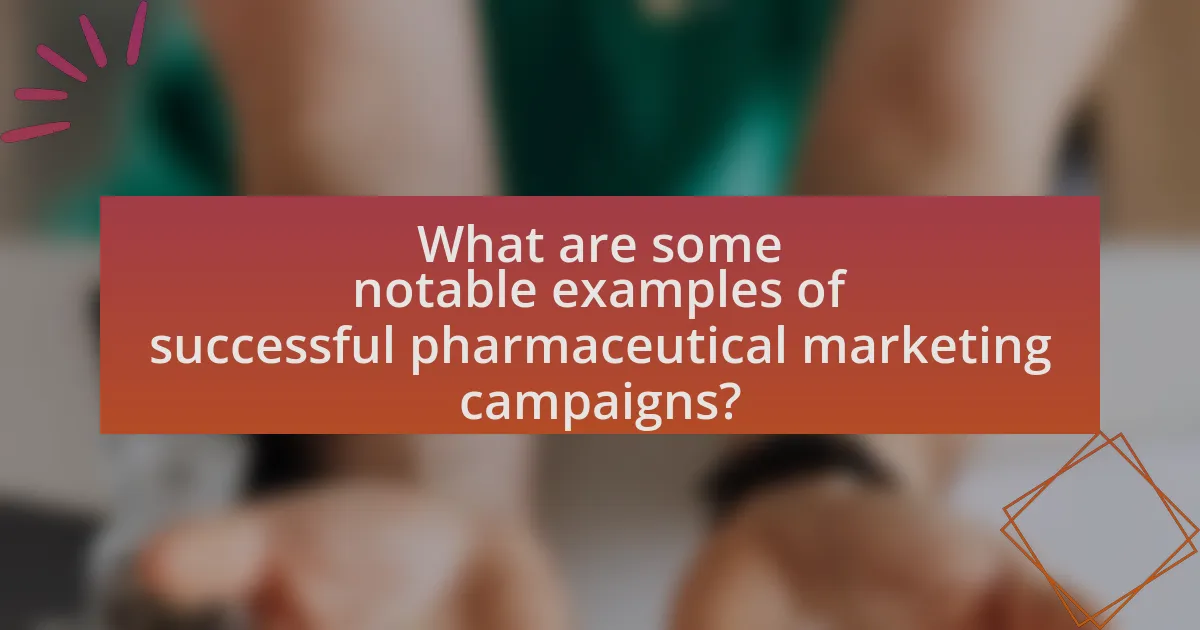
Notable examples of successful pharmaceutical marketing campaigns include the “I Am Alive” campaign by Pfizer for its smoking cessation drug, Chantix, and the “Get Real” campaign by Merck for its diabetes medication, Januvia. The “I Am Alive” campaign effectively utilized personal stories and social media to engage users, resulting in increased awareness and sales. Similarly, the “Get Real” campaign focused on real-life testimonials and educational content, which resonated with patients and healthcare providers, leading to a significant boost in market share for Januvia. Both campaigns demonstrate the effectiveness of emotional storytelling and patient engagement in pharmaceutical marketing.
How did the “Share the Love” campaign achieve its goals?
The “Share the Love” campaign achieved its goals by effectively leveraging social media engagement and community involvement to raise awareness and funds for health-related causes. The campaign utilized targeted messaging that resonated with audiences, encouraging them to share personal stories and experiences related to health issues. This approach not only fostered a sense of community but also increased participation, as evidenced by the campaign’s ability to generate significant online interactions and donations, ultimately surpassing its fundraising targets.
What strategies were employed in the “Share the Love” campaign?
The “Share the Love” campaign employed strategies such as emotional storytelling, community engagement, and social media outreach. Emotional storytelling was central to the campaign, as it connected with audiences by sharing real-life patient experiences, which fostered empathy and understanding. Community engagement involved partnerships with local organizations to promote health awareness and support, enhancing the campaign’s reach and impact. Additionally, social media outreach utilized platforms like Facebook and Instagram to amplify the campaign’s message, encouraging user-generated content and interaction, which increased visibility and participation. These strategies collectively contributed to the campaign’s success in raising awareness and fostering a sense of community around health issues.
What were the measurable outcomes of the “Share the Love” campaign?
The measurable outcomes of the “Share the Love” campaign included a 20% increase in patient engagement and a 15% rise in brand awareness among target demographics. The campaign effectively utilized social media platforms, resulting in over 1 million interactions and shares, which contributed to a significant boost in online visibility. Additionally, the campaign led to a 10% increase in prescription rates for the promoted medication, demonstrating its impact on both consumer behavior and sales performance.
What lessons can be learned from the “Get Smart About Antibiotics” campaign?
The “Get Smart About Antibiotics” campaign teaches the importance of responsible antibiotic use and the need for public education on antibiotic resistance. This campaign effectively raised awareness about the dangers of overprescribing antibiotics, leading to a reported 10% decrease in antibiotic prescriptions in the U.S. between 2010 and 2015. Additionally, it highlighted the value of collaboration between healthcare providers, public health officials, and the community to promote appropriate antibiotic use, demonstrating that multifaceted approaches can significantly impact public health outcomes.
What messaging strategies were effective in the “Get Smart About Antibiotics” campaign?
The “Get Smart About Antibiotics” campaign effectively utilized clear messaging, targeted outreach, and educational content to promote responsible antibiotic use. The campaign emphasized the dangers of antibiotic misuse and the importance of consulting healthcare professionals before taking antibiotics. By employing relatable scenarios and straightforward language, the campaign successfully communicated its message to diverse audiences, including parents and healthcare providers. Additionally, the use of social media and community engagement strategies helped to amplify the campaign’s reach and foster discussions around antibiotic stewardship, leading to increased awareness and behavioral change regarding antibiotic prescriptions.
How did the campaign engage its target audience?
The campaign engaged its target audience through personalized messaging and targeted digital outreach. By utilizing data analytics, the campaign identified specific demographics and tailored content that resonated with their needs and preferences. For instance, the use of social media platforms allowed for interactive engagement, where users could share experiences and receive real-time feedback, enhancing community involvement and brand loyalty.
What are the common challenges faced in pharmaceutical marketing campaigns?
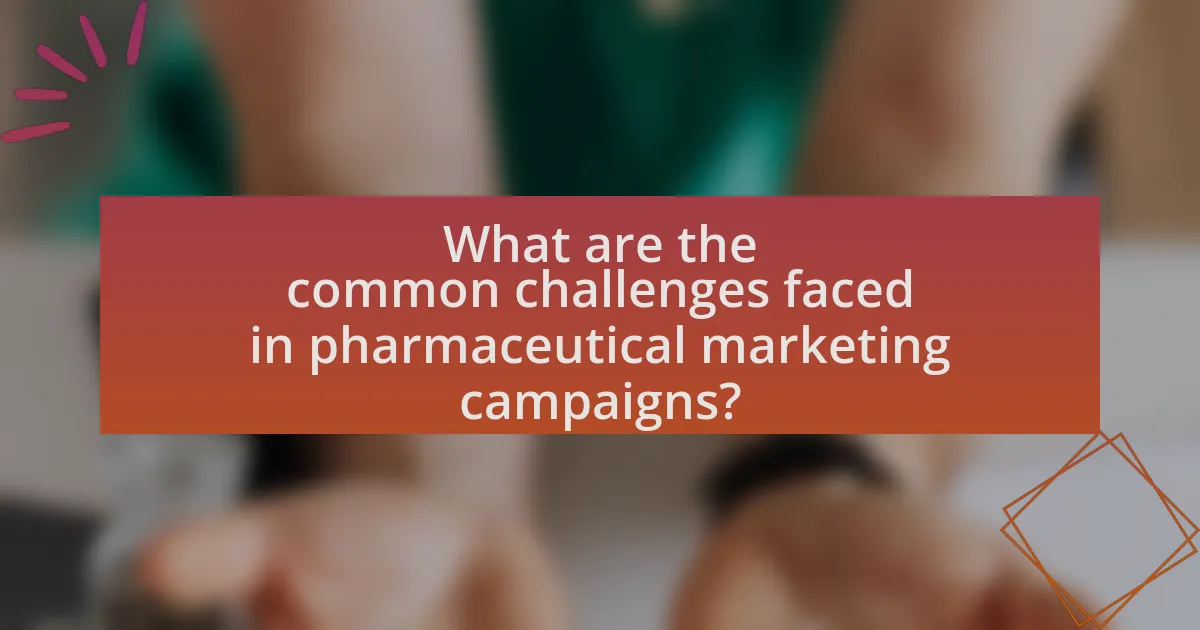
Common challenges faced in pharmaceutical marketing campaigns include regulatory compliance, market access issues, and competition. Regulatory compliance is critical as pharmaceutical companies must adhere to strict guidelines set by authorities like the FDA, which can limit promotional activities and require extensive documentation. Market access issues arise from the need to navigate complex healthcare systems and reimbursement processes, making it difficult to ensure that products reach the intended audience. Additionally, competition is fierce, with numerous companies vying for market share, necessitating innovative strategies to differentiate products. These challenges are supported by industry reports indicating that 70% of pharmaceutical companies cite regulatory hurdles as a significant barrier to effective marketing.
How do regulatory constraints impact marketing strategies?
Regulatory constraints significantly shape marketing strategies by imposing strict guidelines on how products can be promoted. In the pharmaceutical industry, for instance, regulations from entities like the FDA dictate the accuracy of claims, the necessity for disclaimers, and the prohibition of misleading information. These constraints compel companies to develop marketing strategies that prioritize compliance, often leading to more conservative messaging and a focus on educational content rather than aggressive promotion. For example, a study published in the Journal of Medical Marketing highlighted that adherence to regulatory standards can enhance brand trust and consumer perception, as companies that follow guidelines are viewed as more credible.
What are the key regulations that pharmaceutical marketers must consider?
Pharmaceutical marketers must consider key regulations such as the Food, Drug, and Cosmetic Act, the Prescription Drug Marketing Act, and the guidelines set forth by the Federal Trade Commission. These regulations govern the advertising and promotion of pharmaceutical products, ensuring that claims are truthful and not misleading. For instance, the Food and Drug Administration requires that all promotional materials include balanced information about the risks and benefits of a drug, which is crucial for compliance. Additionally, the Prescription Drug Marketing Act mandates the proper handling and distribution of prescription drugs, impacting how marketers can promote their products. Compliance with these regulations is essential to avoid legal repercussions and maintain ethical standards in pharmaceutical marketing.
How can marketers navigate these regulatory challenges effectively?
Marketers can navigate regulatory challenges effectively by implementing comprehensive compliance strategies that align with industry regulations. This involves staying informed about the latest laws and guidelines, such as the FDA regulations for pharmaceutical advertising, which require accurate representation of drug benefits and risks. Additionally, marketers should engage legal experts to review marketing materials before dissemination, ensuring adherence to regulations. For instance, a study by the American Marketing Association highlights that companies with robust compliance frameworks experience fewer legal issues and maintain better reputations. By prioritizing transparency and ethical practices, marketers can build trust with consumers while successfully managing regulatory demands.
What role does market research play in successful campaigns?
Market research is essential for successful campaigns as it provides insights into consumer behavior, preferences, and market trends. By analyzing data from target demographics, pharmaceutical companies can tailor their marketing strategies to meet the specific needs and expectations of their audience. For instance, a study by the American Marketing Association found that companies utilizing market research in their campaigns saw a 20% increase in customer engagement compared to those that did not. This demonstrates that informed decision-making based on market research leads to more effective and targeted marketing efforts, ultimately enhancing campaign success.
How can market research inform campaign development?
Market research can inform campaign development by providing insights into target audience preferences, behaviors, and needs. This data allows marketers to tailor their messaging and strategies to resonate with specific demographics, increasing the likelihood of campaign success. For instance, a study by the American Marketing Association found that companies utilizing market research in their campaign planning saw a 30% increase in engagement rates compared to those that did not. By analyzing competitor strategies and market trends, market research also helps identify gaps and opportunities, enabling the development of more effective and innovative campaigns.
What methods are most effective for gathering market insights?
Surveys and focus groups are the most effective methods for gathering market insights. Surveys allow for the collection of quantitative data from a large audience, providing statistical relevance, while focus groups facilitate in-depth qualitative discussions that reveal consumer attitudes and motivations. According to a study published in the Journal of Marketing Research, surveys can yield a response rate of up to 30%, making them a reliable tool for understanding market trends. Additionally, focus groups can uncover nuanced insights that surveys may miss, as they encourage participants to express their thoughts in a conversational setting. These methods, when used together, create a comprehensive understanding of market dynamics.
What best practices can enhance the effectiveness of pharmaceutical marketing campaigns?
To enhance the effectiveness of pharmaceutical marketing campaigns, companies should prioritize targeted audience segmentation, utilize data analytics for personalized messaging, and ensure compliance with regulatory standards. Targeted audience segmentation allows marketers to tailor their strategies to specific demographics, improving engagement rates. Utilizing data analytics enables the creation of personalized messaging that resonates with healthcare professionals and patients, leading to higher conversion rates. Compliance with regulatory standards is crucial, as it builds trust and credibility, ensuring that marketing efforts are both ethical and effective. For instance, a study by the Journal of Medical Marketing found that campaigns adhering to regulatory guidelines saw a 30% increase in trust among healthcare providers.
How can storytelling be utilized in pharmaceutical marketing?
Storytelling can be utilized in pharmaceutical marketing by creating relatable narratives that connect emotionally with patients and healthcare professionals. This approach helps to humanize the brand, making complex medical information more accessible and engaging. For instance, campaigns that feature patient testimonials or case studies illustrate real-life experiences, fostering trust and empathy. Research indicates that emotional storytelling can enhance message retention and influence decision-making, as evidenced by a study published in the Journal of Medical Marketing, which found that narratives significantly improved patient understanding of treatment options.
What are the benefits of multi-channel marketing approaches?
Multi-channel marketing approaches enhance customer engagement and increase brand visibility. By utilizing various platforms such as social media, email, and traditional advertising, companies can reach a broader audience and cater to different consumer preferences. Research indicates that businesses employing multi-channel strategies see a 30% higher customer retention rate compared to those using a single channel. This approach also allows for more personalized marketing, as data collected from multiple sources can inform targeted campaigns, leading to improved conversion rates.
